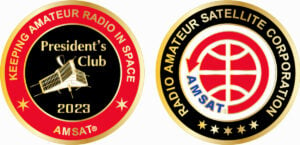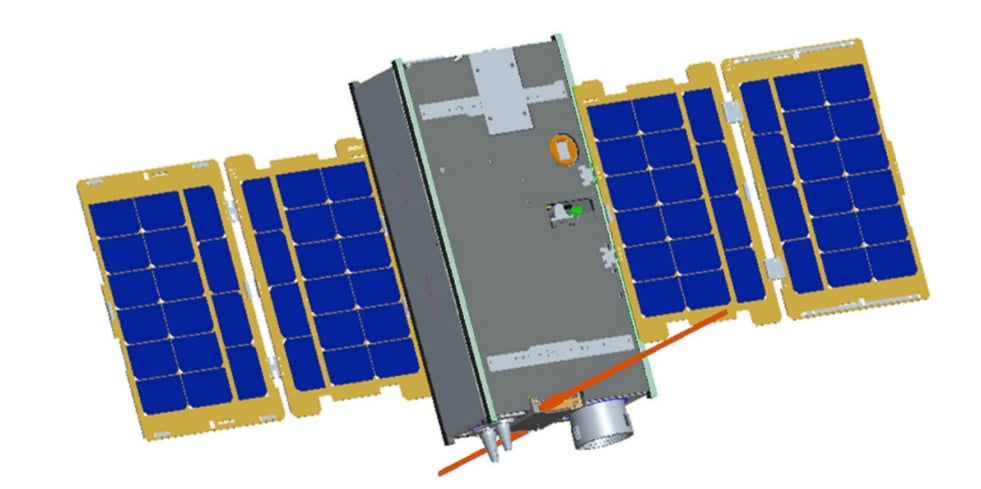AMSAT NEWS SERVICE
ANS-029
In this edition:
* LUSAT LO-19 33Y Anniversary
* FalconSAT-3 Has Re-entered
* Rocket Lab launches first Electron mission from US
* Changes to AMSAT-NA TLE Distribution for January 26, 2022
* ARISS News
* Upcoming Satellite Operations
* Hamfests, Conventions, Maker Faires, and Other Events
* Satellite Shorts From All Over
The AMSAT News Service bulletins are a free, weekly news and information service of AMSAT, The Radio Amateur Satellite Corporation. ANS publishes news related to Amateur Radio in Space including reports on the activities of a worldwide group of Amateur Radio operators who share an active interest in designing, building, launching and communicating through analog and digital Amateur Radio satellites.
The news feed on http://www.amsat.org publishes news of Amateur Radio in Space as soon as our volunteers can post it.
Please send any amateur satellite news or reports to: ans-editor [at] amsat.org
You can sign up for free e-mail delivery of the AMSAT News Service Bulletins via the ANS List; to join this list see: https://mailman.amsat.org/postorius/lists/ans.amsat.org/
ANS-029 AMSAT News Service Weekly Bulletins
To: All RADIO AMATEURS
From: Radio Amateur Satellite Corporation
712 H Street NE, Suite 1653
Washington, DC 20002
DATE 2023 Jan 29
+=+=+=+=+=+=+=+=+=+=+=+=+=+=+=+=+=+=+=+=+=+=+=+=+=+=+=+=+=+=+=+=+=+=+
The 2023 AMSAT President’s Club coins are here now!
To commemorate the 40th anniversary of its launch on June 16, 1983,
this year’s coin features an image of AMSAT-OSCAR 10. Join the AMSAT
President’s Club today and help Keep Amateur Radio in Space!
https://www.amsat.org/join-the-amsat-presidents-club/
+=+=+=+=+=+=+=+=+=+=+=+=+=+=+=+=+=+=+=+=+=+=+=+=+=+=+=+=+=+=+=+=+=+=+
LUSAT LO-19 33Y Aniversary
Today, Jan-22, 33 years ago was launched LO-19, LUSAT, 1st Argentine Satellite, till now emitting on 437.125 KHz.
A special Certificate to celebrate is being granted by radio from Jan-21 to Jan-29, thru many collaborating stations.
Details: http://amsat.org.ar?f=33 http://qrz.com/db/LU7AA https://www.qrzcq.com/call/LU7AA (last in english)
LUSAT could be tracked/seen thru http://amsat.org.ar/pass?satx=lusat
Deep appreciation to AMSAT-NA that in the eighties developed the AO-16 & LO-19 novel PACSAT protocol and lead on design and launch.
Thanks! 73, LU7AA, AMSAT Argentina http://amsat.org.ar
[ANS thanks AMSAT Argentina LU7AA Team for the above information]
FalconSAT-3 Has Re-entered
The 18th Space Defense Squadron has confirmed the orbital decay of FalconSAT-3. Thanks to the U. S. Air Force Academy for allowing amateur satellite operators its use as an amateur radio digipeater/PACSAT BBS for the past 5+ years following the conclusion of the satellite’s primary mission.
[ANS thanks AMSAT for the above information]
+=+=+=+=+=+=+=+=+=+=+=+=+=+=+=+=+=+=+=+=+=+=+=+=+=+=+=+=+=+=+=+=+=+
Need new satellite antennas?
Purchase Arrows, Alaskan Arrows, and M2 LEO-Packs from the AMSAT Store.
When you purchase through AMSAT, a portion of the proceeds
goes towards Keeping Amateur Radio in Space.
https://amsat.org/product-category/hardware/
+=+=+=+=+=+=+=+=+=+=+=+=+=+=+=+=+=+=+=+=+=+=+=+=+=+=+=+=+=+=+=+=+=+
Rocket Lab launches first Electron mission from US
Rocket Lab USA, Inc. has launched its 33rd Electron rocket and first mission from Virginia. The “Virginia is for Launch Lovers” mission lifted off at 18:00 EST on January 24th from Rocket Lab Launch Complex 2 (LC-2) at Virginia Space’s Mid-Atlantic Regional Spaceport within NASA’s Wallops Flight Facility. The mission deployed three satellites to a 550km orbit for leading radio frequency geospatial analytics provider HawkEye 360. Rocket Lab has now successfully deployed a total of 155 satellites to orbit from the Company’s three launch pads across the U.S. and New Zealand.
The successful launch from LC-2 marks the beginning of a new era of responsive launch capability for small satellites from U.S. soil. Built with support from Virginia Space, the Commonwealth of Virginia and NASA Wallops Flight Facility, Rocket Lab Launch Complex 2 is designed to serve the responsive space needs of commercial, civil, defense, and national security customers, supporting up to 12 missions per year. More information may be found at: https://bit.ly/3kyNU3M.
[ANS thanks Space Daily for the above information]
+=+=+=+=+=+=+=+=+=+=+=+=+=+=+=+=+=+=+=+=+=+=+=+=+=+=+=+=+=+=+=+=+=+
Want to fly the colors on your own grid expedition?
Get your AMSAT car flag and other neat stuff from our Zazzle store! 2
5% of the purchase price of each product goes towards
Keeping Amateur Radio in Space
https://www.zazzle.com/amsat_gear
+=+=+=+=+=+=+=+=+=+=+=+=+=+=+=+=+=+=+=+=+=+=+=+=+=+=+=+=+=+=+=+=+=+
Changes to AMSAT-NA TLE Distribution for January 26, 2023
Two Line Elements or TLEs, often referred to as Keplerian elements or keps in the amateur community, are the inputs to the SGP4 standard mathematical model of spacecraft orbits used by most amateur tracking programs. Weekly updates are completely adequate for most amateur satellites. TLE bulletin files are updated Thursday evenings around 2300 UTC, or more frequently if new high interest satellites are launched. More information may be found at https://www.amsat.org/keplerian-elements-resources/
The following satellites have decayed from orbit and have been removed from this week’s AMSAT-NA TLE distribution:
Falconsat-3 NORAD Cat ID 30776 (decayed from orbit on 01/21/23 per Space-Track).
JAGSAT NORAD Cat ID 53771 (decayed from orbit on 01/23/23 per Space-Track).
[ANS thanks Ray Hoad, WA5QGD, AMSAT Orbital Elements Manager, for the above information]
ARISS News
Amateurs and others around the world may listen in on contacts between amateurs operating in schools and allowing students to interact with astronauts and cosmonauts aboard the International Space Station. The downlink frequency on which to listen is 145.800 MHz worldwide.
Norwich Free Academy, Norwich, CT, direct via W1HLO. The ISS callsign is presently scheduled to be NA1SS. The downlink frequency is presently scheduled to be 145.800 MHz. The scheduled crewmember is Josh Cassada KI5CRH. Contact is go for: Mon 2023-01-30 18:55:20 UTC 43 deg
Dinskaya, Russia, direct via TBD. The ISS callsign is presently scheduled to be RSØISS. The downlink frequency is presently scheduled to be 145.800 MHz. The scheduled crewmember is Anna Kikina. Contact is go for Thu 2023-02-02 15:10 UTC
Nizhny Novgorod, Russia, direct via TBDThe ISS callsign is presently scheduled to be RSØISS. The downlink frequency is presently scheduled to be 145.800 MHz. The scheduled crewmember is Dimitri Petelin. Contact is go for Sat 2023-02-04 10:25 UTC
The latest information on the operation mode can be found at https://www.ariss.org/current-status-of-iss-stations.html
The latest list of frequencies in use can be found at https://www.ariss.org/contact-the-iss.html
ARISS from Twitter: We’ve updated our username here on Twitter to @ARISS_Intl to make us easier to find. If you are all ready following, thanks! There’s nothing for you to do.
[ANS thanks Charlie Sufana, AJ9N, one of the ARISS operation team mentors for the above information]
Upcoming Satellite Operations
Chris VE3FU / VO2AC / VO1FUA / VE2FUA: The weekend of January 27-29 @Dave_VE3KG and VE3FU will plan on operating the linear and FM satellites from grid GO11 as VO2AC and VO2AAA from January 24-27. (Ed. Note: Not yet specified which passes they might work)
JD1YCC ( G-G HAM Club ) is planning to activate EME operation on 2m/70cm/23cm band at Ogasawara chichi island(JD1/O) from Feb.07 to Feb.13 2023. They plan to QRV on GREENCUBE/IO-117 also (EME) at Moon time. Op will be JJ3JHP/JD1BQD Hiro.
[ANS thanks Paul Overn, KE0PBR, AMSAT rover page manager, and Masaji “Masa” Ishihara JH3BUM/JD1BPX for the above information]
Hamfests, Conventions, Maker Faires, and Other Events
AMSAT Ambassadors provide presentations, demonstrate communicating through amateur satellites, and host information tables at club meetings, hamfests, conventions, maker faires, and other events.
AMSAT Ambassador Clint Bradford K6LCS has a few satellite presentations scheduled, most notable is Thames Valley, England (5/11/23)
Clint can be reached at: (909) 999-7287 or an email link at https://www.work-sat.com/contact.html.
2023 HamCation(r)
Hosting ARRL Southeastern Division Convention
Robert Bankston, KE4AL AMSAT President, will present “Shaping the Amateur Radio Satellite World of Tomorrow” at 2:00PM – 3:00PM EST Saturday, February 11 in the OS Pavillion.
HamCation will be held at Central Florida Fairgrounds and Expo Park, Orlando, FLFriday, Saturday, and Sunday, February 10-12, 2023
[ANS thanks Paul Overn, KE0PBR, AMSAT Events page manager, for the above information]
Satellite Shorts From All Over
+ A volunteer is being sought to take over the Gridmaster Heat Map on Twitter. Paul Overn, KE0PBR, has announced his intent to retire from the project that he has moderated there for the past three years. Paul has assisted many grid chasers by relaying information about rovers, and keeping tabs of which grids are in greatest need. Unless someone steps forward, Gridmaster Heat Map will disappear next month. Thanks to Paul for your valuable contribution to satellite operations! (ANS thanks Paul Overn, KE0PBR, for the above information)
+ SpaceX successfully performed the first WDR of Starship Booster 7 and Ship 24 on Monday. This is a major milestone in any rockets march towards a first launch, especially for a super heavy lift monster like Starship, which will have more than twice the thrust of the Saturn V. SpaceX loaded 4.5 million kg of cryogenic propellant into the fully reusable, two-stage rocket (causing it to shrink noticeably) and performed a countdown as it would on launch day (including some massive venting). A 33-engine static fire is now the next dramatic step toward an orbital launch, although how soon that might happen is unknown. (ANS thanks The Orbital Index for the above information)
+ Next-gen propulsion incoming? Yesterday, NASA announced a new collaboration with long-time partner DARPA to develop a Nuclear Thermal Propulsion (NTP) system and spacecraft. NTP promises 3x or more improvements in Isp over traditional chemical rockets by heating a low molecular mass propellant (like hydrogen) to high temps using a reactor and then expelling the expanded propellant out a rocket nozzle (this achieves high exhaust velocities while needing no oxidizer, saving mass). DARPA will continue to develop DRACO, an orbital and cislunar NTP-powered experimental spacecraft (cf. Issue No. 170) as part of this collaboration, and the agencies are targeting an in-space demonstration of the propulsion system as soon as 2027. The demonstration spacecraft could be used as low as 700 km or as high as 2,000 km, but the long-term vision is cislunar space and Mars. This collaboration is separate from other recent NTP projects like the DOE’s initiative. (ANS thanks The Orbital Index for the above information)
Join AMSAT today at https://launch.amsat.org/
In addition to regular membership, AMSAT offers membership to:
* Societies (a recognized group, clubs or organization).
* Primary and secondary school students are eligible for membership at one-half the standard yearly rate.
* Post-secondary school students enrolled in at least half time status shall be eligible for the student rate for a maximum of 6 post-secondary years in this status.
* Memberships are available for annual and lifetime terms.
Contact info [at] amsat.org for additional membership information.
73 and remember to help Keep Amateur Radio in Space!
This week’s ANS Editor,
Jack Spitznagel, KD4IZ
kd4iz [at] frawg.org



